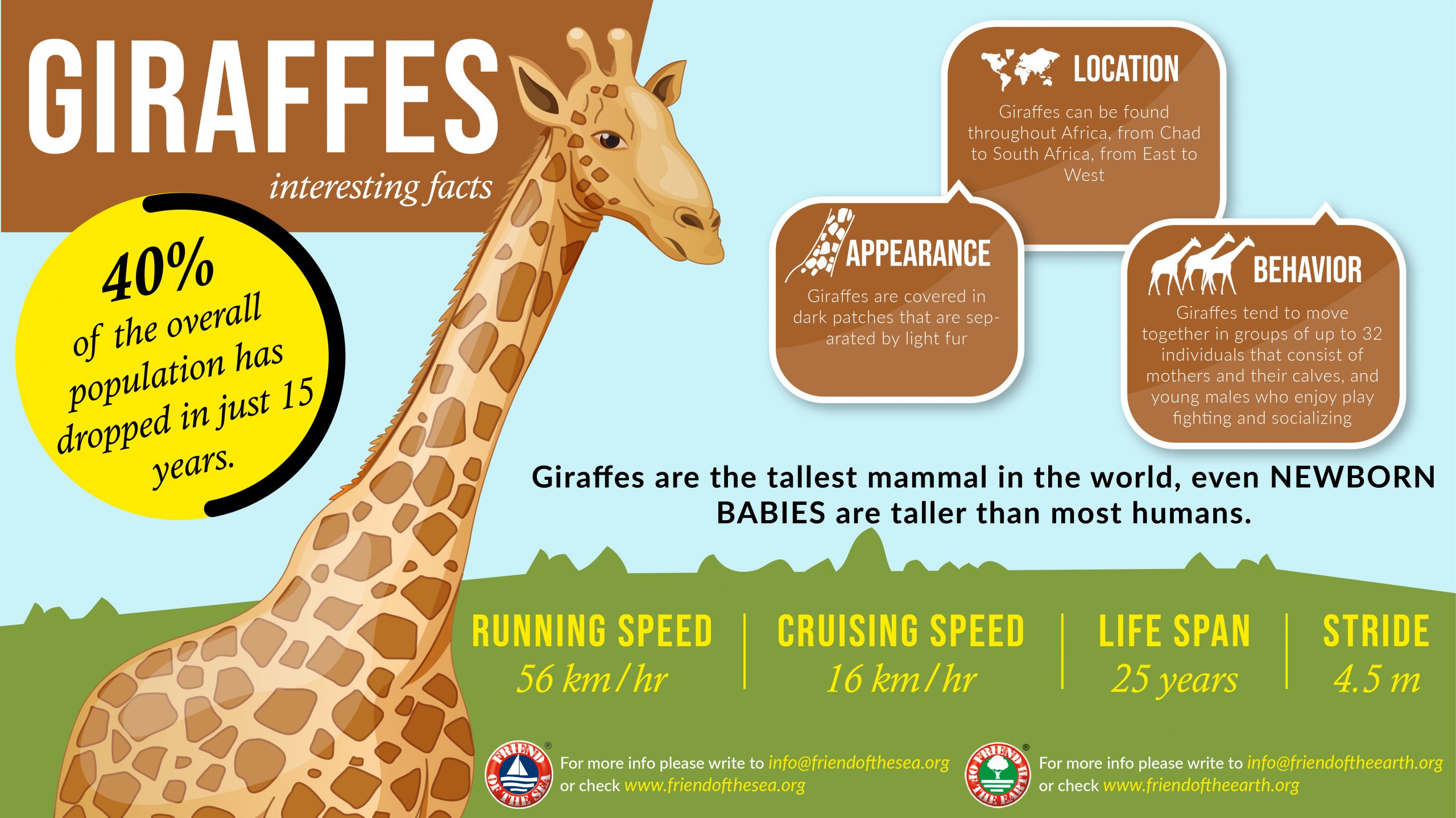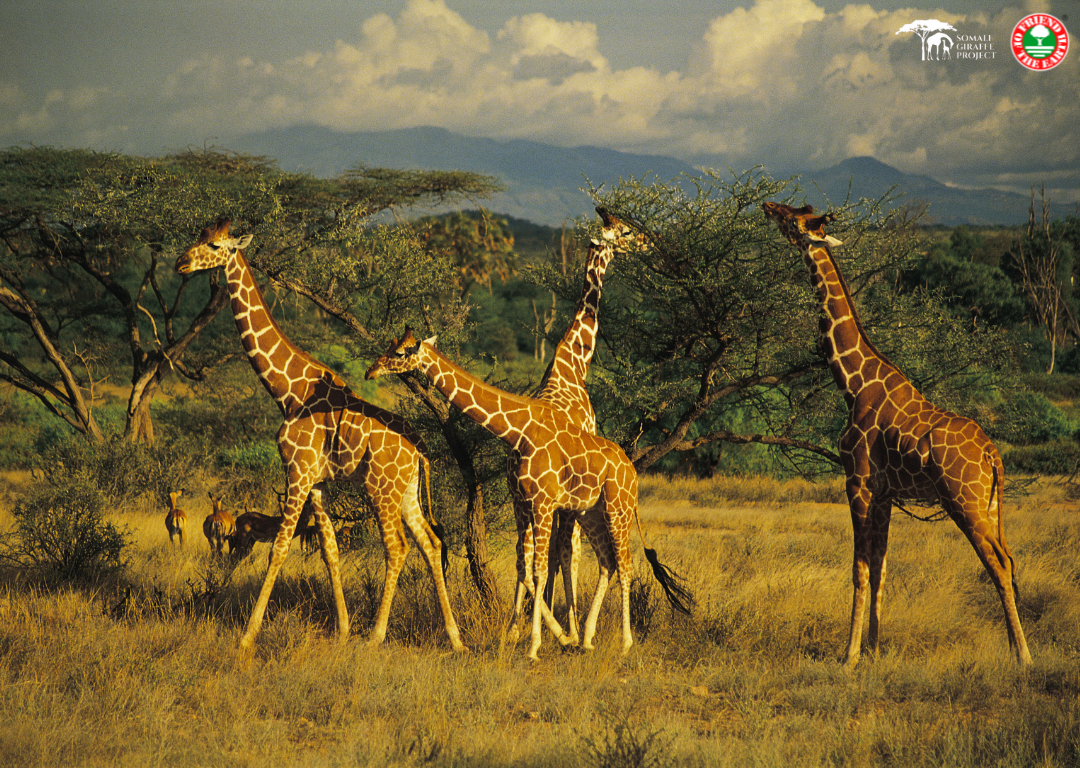Save the Giraffes
The giraffe is the tallest land animal on the planet at almost 6m in height! It feeds on acacia leaves and its prehensile tongue is blue[1], a rare color in nature with the role of defense from the powerful African sun rays.[2]
The Problem
Habitat degradation is a major factor in the decline of populations. These issues arise from an increasing human population and conversion of land to agriculture and man-made structures, including buildings and roads.
Giraffes are also hunted for their meat, demanded by local communities. In some African cultures, giraffe tails are also used as “good luck” charms.[3]
Once distributed throughout the African continent, the giraffe is now localized in only a few countries. In the 2016 IUCN had simply cataloged it as Vulnerable (VU), while in a 2018 update all species and subspecies changed the wording to Near Threated (NT), Endangered (EN), Critically Endangered (CR).[4]
The populations have declined 30% over just15 years and in some areas as much as s95%. There are now approximately 117,000 giraffes left in the wild. The remaining herds are fragmented and face a multitude of threats, from habitat loss to poaching.[5]
[1] Treccani: https://www.treccani.it/enciclopedia/giraffa/
[2] GCF: https://giraffeconservation.org/facts/how-long-is-a-giraffes-tongue-what-colour-is-it/
[3] Center for Biological Biodiversity: https://www.biologicaldiversity.org/species/mammals/giraffe/index.html
[4] GCF IUCN: https://giraffeconservation.org/2018/11/14/giraffe-subspecies-update/
[5] GCF Giraffe Status: https://giraffeconservation.org/giraffe-conservation-status/

Environmental Consequences
Giraffes are known as keystone herbivores. This means that they have a pivotal role in the ecosystem that cannot be filled by other species.
Thanks to their long necks, giraffes consume plant species that are out of reach for most other animals. By eating swathes of leaves and shrubbery from the tops of trees, giraffes open areas of habitat, letting more sun reach the lower levels of vegetation and thus promoting growth of a greater range of plant species. They also distribute the seeds of these species that are out of reach for most other seed dispersers. Without giraffes, the ecosystem would change, and other animals and plants would suffer.[6]
[6] Cambridge University Press: https://www.cambridge.org/core/journals/journal-of-zoology/article/abs/diet-and-ecological-role-of-giraffe-giraffa-camelopardalis-introduced-to-the-eastern-cape-south-africa/C65D15AF66C1C22F75B9F39492C1A714
Possible Solutions
Conservation efforts to save giraffes are largely focused on habitat protection and anti-poaching campaigns. Efforts are underway to reforest key areas with acacia trees – a favorite of the giraffe.
Education and outreach programs are underway in all the countries where giraffes are still found. The value of giraffes for tourism and ecosystems is being taught to local people and behaviour change programs are underway.
Further scientific research is needed to improve the understanding of the requirements of the four species of giraffe and identify the key threats.
Social studies are underway to garner a better understanding of the use of giraffes in traditional medicine and for bush meat and how the animals are viewed by local populations.
WSF Activities and initiatives
The World Sustainability Foundation provided financial support for the Somali Giraffe Project, a trans-boundary community-based conservation project that focuses on the conservation and recovery of the endangered reticulated giraffe through research, education, and community involvement in Kenya.
By raising funds and awareness, we helped the Somali Giraffe Project to support rangers involved in anti-poaching activities in Garissa’s area and to minimize the giraffes-farmers conflict.

Call to action
- Help conserve Earth’s tallest species of land animal in their increasingly fragmented habitats.
- Choose only Friend of the Earth certified products.
- Sign Friend of the Earth petition on Change.org
- Donate to Friend of the Earth for giraffe’s conservation.
- Be sure to get involved with World Giraffe Day on 21 June!










